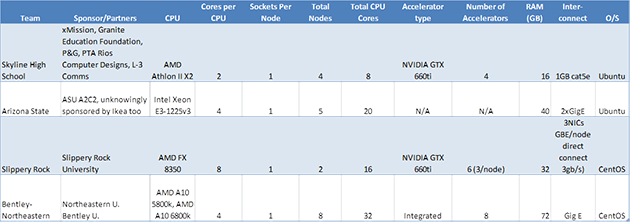This article is more than 1 year old
Mini-cluster competitor configs revealed
$2,500 limit is no bar to student imaginations
SC'13 The students in the Commodity Track of the SC13 Student Cluster Competition in Denver faced quite a challenge last week. They had to build at least a dual-node HPC cluster, but could only spend a total of $2,500 on it.
There are lots of ways to go. You can get the smallest/cheapest motherboards possible and string a bunch of them together - like harnessing a bunch of gerbils to pull your wagon. Or you could opt for two much more powerful PC-like nodes, which would be more like using two medium sized dogs to drag the load.
Let's see how the three university teams (plus one group of high schoolers) solved the problem.

Not surprisingly, they took some very creative approaches - some of which will show up much better on the upcoming video blogs that look at each team's creations.
However, there's quite a bit of variety just looking at the stats on the table above. Slippery Rock went with two nodes driven by a couple of 8-core AMD CPUs and augmented with four NVIDIA GTX 660ti GPUs to give it a powerful punch on number crunching. Team Rock also dispensed with the conventional gigabit Ethernet switch in favor of a direct Ethernet connection between their two nodes.
Arizona State opted for fewer nodes, but more cores, and eschewed the accelerators in favor of more CPU power. As you'll see in an upcoming video, they used a small Ikea set of drawers to house their cluster - which was a very cool approach and garnered a lot of attention at the show.
Skyline didn't put a lot of money into the aesthetics. They found some old PC cases and replaced the innards with as much computing goodness as they could fit into their $2,500 budget. Like Slippery Rock, they also went with the NVIDIA GTX 660 ti (must have been a sale on them), but didn't configure quite as much memory as the other teams. It's also interesting to see that these kids gathered a lot of support from their community to help defray their non-system costs. Good job on that.
The team fielded by Bentley University and Northeastern U managed took a different route than the others. They fielded the only integrated hybrid CPU-GPU solution by using AMD's A10 processors. This gave them a larger core count than other competitors, with enough budget room to score 72GB of RAM - significantly more than anyone else.
Our next articles will be video blogs that show the systems and chat with the teams about what they're running and how they managed to stay under the dollar limit. Stay tuned ...
